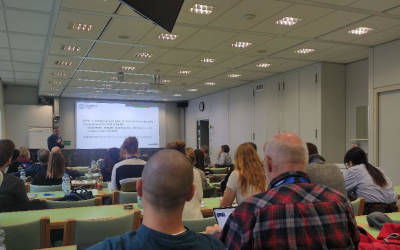Annual Meeting - 2024
BEHIND-MS Annual Meeting in Heidelberg
Posted on November 28, 2024 • 4 minutes • 844 words
Table of contents
Exploring New Frontiers in Multiple Sclerosis Research: The BEHIND-MS Annual Meeting in Heidelberg
This week, leading researchers, clinicians, and patient advocates gathered in Heidelberg for the first annual meeting of the BEHIND-MS project , a groundbreaking EU-funded research initiative. The project is focused on understanding how the Epstein-Barr virus (EBV) could be a critical factor in the development of Multiple Sclerosis (MS). As the world’s most common neuroinflammatory disease, MS affects millions of people globally, and while current therapies can slow its progression, a definitive cure remains elusive. Recent findings, however, suggest a possible connection between EBV infection and MS, potentially transforming the field.
The BEHIND-MS project aims to clarify this link, offering new hope for earlier diagnosis, more effective prevention strategies, and innovative treatments.
Why is EBV important in MS research?
For years, scientists have searched for the root causes of MS. While genetics and environmental factors play roles, no single factor has been as promising a lead as the Epstein-Barr virus. Recent studies indicate that individuals infected with EBV face a significantly higher risk of developing MS, and nearly all people with MS have evidence of past EBV infection. The BEHIND-MS project is dedicated to understanding this relationship, studying how EBV interacts with the immune system and triggers neuroinflammation in people predisposed to MS.
The BEHIND-MS project: Objectives and approach
The BEHIND-MS project, led by Professor Henri-Jacques Delecluse at the German Cancer Research Center (DKFZ ), unites experts from multiple disciplines to uncover the role of EBV in MS. By developing advanced laboratory and animal models, the team can closely examine how EBV and the immune system interact, particularly in individuals genetically predisposed to MS.
These models will combine human brain cells, immune cells, and the virus itself, providing a unique look into how MS might develop and progress. Additionally, researchers are working to identify biomarkers that can detect EBV infection in MS patients, which could lead to earlier diagnosis and more targeted treatments. Through these efforts, BEHIND-MS aims to deepen understanding of MS mechanisms and create new pathways for diagnosis, prevention, and therapy.
Highlights from the BEHIND-MS Annual Meeting?
The recent BEHIND-MS Annual Meeting in Heidelberg brought together consortium partners to review progress and discuss future directions. Each work package presented their year-one achievements, showcasing the collaborative efforts advancing MS and EBV research.
Key updates included:
-
Scientific progress: Efforts to create detailed maps of how EBV interacts with immune cells in the blood and central nervous system of people with MS were discussed. Updates included insights into immune cell activity, metabolic changes, and the role of genetic factors in these interactions. In addition, progress in preclinical mouse models, aiming to offer a better understanding of early disease mechanisms and the ability to test potential treatments.
-
Data management: Partners presented findings from the first year of the project and efforts to ensure that the BEHIND-MS project’s data is secure and well managed across teams, showcasing their developments in data science and data management.
-
Communication and Patient Advocacy: The team outlined the strategies and achievements of the past year in sharing research progress and engaging the MS community. This work package emphasizes the importance of making research accessible and actionable for patients, families, and advocacy groups.
EBV-MS: A collaborative opportunity
During the meeting, the EBV-MS project team introduced their complementary research efforts. Prof. Torkildsen shared the EBV-MS research plans, outlining their approach to studying EBV interactions with the immune system in MS. By presenting their upcoming objectives and methodologies, the team set the stage for future collaboration with BEHIND-MS, aiming to strengthen collective insights into EBV’s role in MS and accelerate advancements in understanding, prevention, and potential treatment strategies.
Patient involvement: A key element
A defining feature of the BEHIND-MS project is its commitment to integrating the perspectives of people with MS. Patient advocates, including EMSP representatives, are closely involved in the project’s communication and dissemination activities, helping to ensure that research aligns with the needs and experiences of the MS community. The insights shared by Jana Hlavacova, patient representative on the External Advisory Board, will ensure that BEHIND-MS’s findings directly contribute to improving quality of life and treatment outcomes.

Looking ahead: The future impact of BEHIND-MS
The BEHIND-MS project is at the forefront of a new era in MS research. By bringing together a multidisciplinary team and leveraging cutting-edge experimental models, this initiative has the potential to reshape the understanding of MS and pave the way for new treatments. As data from BEHIND-MS continue to unfold, it is hoped that we will gain a clearer picture of how EBV contributes to MS, inspiring innovative therapies that reduce the disease burden for millions worldwide.
Stay tuned for updates as the BEHIND-MS project progresses: https://www.behind-ms.eu . With collaborative efforts and the commitment of researchers, clinicians, and patient advocates, we’re moving closer to a future where MS is better understood, more effectively treated, and perhaps one day, prevented.
We thank all consortium partners for their efforts during year 1 of the BEHIND-MS project and look forward to close collaboration in upcoming years of the project!
